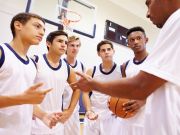- Skip Storing This Everyday Product in the Fridge Door
- Green Tea + B3 Pairing May Boost Brain Health
- Navigating Your Midlife Crisis: Embracing New Possibilities
- City Raccoons Showing Signs of Domestication
- Mapping the Exposome: Science Broadens Focus to Environmental Disease Triggers
- One Week Less on Social Media Linked to Better Mental Health
- Your Brain Changes in Stages as You Age, Study Finds
- Some Suicide Victims Show No Typical Warning Signs, Study Finds
- ByHeart Formula Faces Lawsuits After Babies Sickened With Botulism
- Switch to Vegan Diet Could Cut Your Greenhouse Gas Emissions in Half
Will Your Kid Play School Sports This Fall? Here’s Some Guidance on Doing It Safely

If you’re thinking about letting your child resume sports while the coronavirus pandemic continues to rage, a leading pediatricians’ group says there are a few things you should consider.
To help families make informed decisions, the American Academy of Pediatrics (AAP) recently released guidance based on the most current research.
“We recommend that parents talk to their pediatrician about the type of sport and setting, local disease activity, and individual circumstances, such as an underlying health condition that places the athlete or family members at high risk,” Dr. Susannah Briskin, one of the guidance authors, said in an AAP news release.
“The risk can be decreased, but not eliminated, by athletes, parents, coaches and officials who follow safety protocols. Ultimately, this will be an individual choice for the parent to decide if they will allow their child to participate in sports,” she advised.
“Before returning to sports, all children should have an annual health visit that ideally includes a pre-participation physical evaluation, which most parents know as a sports exam,” Briskin said. “If kids have not been physically active for a lengthy period of time, they are at higher risk of an overuse injury.”
Parents can expect sports governing bodies to recommend pandemic-related modifications to practices, competitions and events.
The AAP guidance says that families, coaches and teams should: prioritize non-contact activity such as conditioning and drills where physical distance can be maintained; emphasize proper hygiene and respiratory etiquette with signs, parent/athlete education, and frequent use of hand-washing stations or hand sanitizer; and create small practice groups that don’t mix with others to help limit team-wide outbreaks.
When physical distancing can’t be maintained, athletes should wear a cloth face covering during non-vigorous exercise. Cloth face coverings should not be worn in water activities or in activities where they could pose an injury risk due to snagging on equipment or accidentally impairing vision.
Frequently touched surfaces on fields, courts, or play surfaces should be cleaned and disinfected at least daily or between uses as much as possible, and sharing of equipment and use of communal spaces like locker rooms should be reduced when possible, the guidance says.
Athletes should not share food or drink, and those with any COVID-19 symptoms should not attend practices or competition, and should see their doctor before returning to sports.
Travel to other communities and regions should be avoided or kept to a minimum, the guidance recommends.
“We know that children are suffering without their usual sports activities this summer and would really like to see them regain some of the fun and healthy benefits of athletics and games,” Briskin said. “All of us are in this together. By following safety precautions, we can work toward minimizing risk and allowing some return to the sports activities.”
More information
The American Academy of Pediatrics has more on COVID-19.
Source: HealthDay
Copyright © 2025 HealthDay. All rights reserved.










